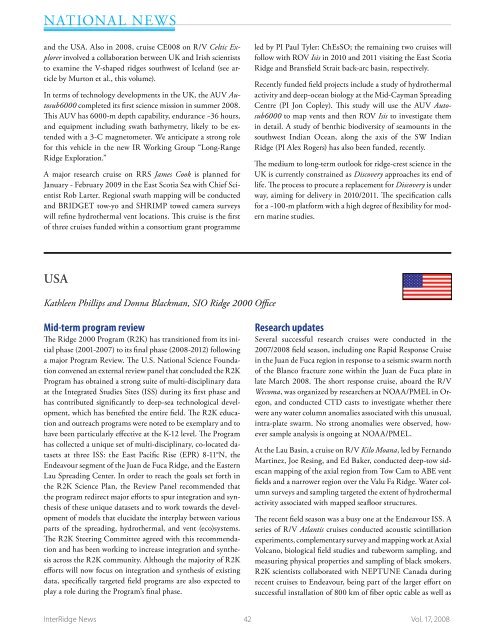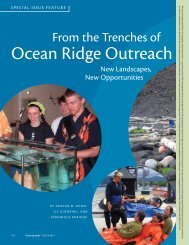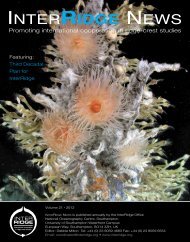Full version, lower resolution, 3.25MB - InterRidge
Full version, lower resolution, 3.25MB - InterRidge
Full version, lower resolution, 3.25MB - InterRidge
Create successful ePaper yourself
Turn your PDF publications into a flip-book with our unique Google optimized e-Paper software.
National News<br />
and the USA. Also in 2008, cruise CE008 on R/V Celtic Explorer<br />
involved a collaboration between UK and Irish scientists<br />
to examine the V-shaped ridges southwest of Iceland (see article<br />
by Murton et al., this volume).<br />
In terms of technology developments in the UK, the AUV Autosub6000<br />
completed its first science mission in summer 2008.<br />
This AUV has 6000-m depth capability, endurance ~36 hours,<br />
and equipment including swath bathymetry, likely to be extended<br />
with a 3-C magnetometer. We anticipate a strong role<br />
for this vehicle in the new IR Working Group “Long-Range<br />
Ridge Exploration.”<br />
A major research cruise on RRS James Cook is planned for<br />
January - February 2009 in the East Scotia Sea with Chief Scientist<br />
Rob Larter. Regional swath mapping will be conducted<br />
and BRIDGET tow-yo and SHRIMP towed camera surveys<br />
will refine hydrothermal vent locations. This cruise is the first<br />
of three cruises funded within a consortium grant programme<br />
led by PI Paul Tyler: ChEsSO; the remaining two cruises will<br />
follow with ROV Isis in 2010 and 2011 visiting the East Scotia<br />
Ridge and Bransfield Strait back-arc basin, respectively.<br />
Recently funded field projects include a study of hydrothermal<br />
activity and deep-ocean biology at the Mid-Cayman Spreading<br />
Centre (PI Jon Copley). This study will use the AUV Autosub6000<br />
to map vents and then ROV Isis to investigate them<br />
in detail. A study of benthic biodiversity of seamounts in the<br />
southwest Indian Ocean, along the axis of the SW Indian<br />
Ridge (PI Alex Rogers) has also been funded, recently.<br />
The medium to long-term outlook for ridge-crest science in the<br />
UK is currently constrained as Discovery approaches its end of<br />
life. The process to procure a replacement for Discovery is under<br />
way, aiming for delivery in 2010/2011. The specification calls<br />
for a ~100-m platform with a high degree of flexibility for modern<br />
marine studies.<br />
USA<br />
Kathleen Phillips and Donna Blackman, SIO Ridge 2000 Office<br />
Mid-term program review<br />
The Ridge 2000 Program (R2K) has transitioned from its initial<br />
phase (2001-2007) to its final phase (2008-2012) following<br />
a major Program Review. The U.S. National Science Foundation<br />
convened an external review panel that concluded the R2K<br />
Program has obtained a strong suite of multi-disciplinary data<br />
at the Integrated Studies Sites (ISS) during its first phase and<br />
has contributed significantly to deep-sea technological development,<br />
which has benefited the entire field. The R2K education<br />
and outreach programs were noted to be exemplary and to<br />
have been particularly effective at the K-12 level. The Program<br />
has collected a unique set of multi-disciplinary, co-located datasets<br />
at three ISS: the East Pacific Rise (EPR) 8-11°N, the<br />
Endeavour segment of the Juan de Fuca Ridge, and the Eastern<br />
Lau Spreading Center. In order to reach the goals set forth in<br />
the R2K Science Plan, the Review Panel recommended that<br />
the program redirect major efforts to spur integration and synthesis<br />
of these unique datasets and to work towards the development<br />
of models that elucidate the interplay between various<br />
parts of the spreading, hydrothermal, and vent (eco)systems.<br />
The R2K Steering Committee agreed with this recommendation<br />
and has been working to increase integration and synthesis<br />
across the R2K community. Although the majority of R2K<br />
efforts will now focus on integration and synthesis of existing<br />
data, specifically targeted field programs are also expected to<br />
play a role during the Program’s final phase.<br />
Research updates<br />
Several successful research cruises were conducted in the<br />
2007/2008 field season, including one Rapid Response Cruise<br />
in the Juan de Fuca region in response to a seismic swarm north<br />
of the Blanco fracture zone within the Juan de Fuca plate in<br />
late March 2008. The short response cruise, aboard the R/V<br />
Wecoma, was organized by researchers at NOAA/PMEL in Oregon,<br />
and conducted CTD casts to investigate whether there<br />
were any water column anomalies associated with this unusual,<br />
intra-plate swarm. No strong anomalies were observed, however<br />
sample analysis is ongoing at NOAA/PMEL.<br />
At the Lau Basin, a cruise on R/V Kilo Moana, led by Fernando<br />
Martinez, Joe Resing, and Ed Baker, conducted deep-tow sidescan<br />
mapping of the axial region from Tow Cam to ABE vent<br />
fields and a narrower region over the Valu Fa Ridge. Water column<br />
surveys and sampling targeted the extent of hydrothermal<br />
activity associated with mapped seafloor structures.<br />
The recent field season was a busy one at the Endeavour ISS. A<br />
series of R/V Atlantis cruises conducted acoustic scintillation<br />
experiments, complementary survey and mapping work at Axial<br />
Volcano, biological field studies and tubeworm sampling, and<br />
measuring physical properties and sampling of black smokers.<br />
R2K scientists collaborated with NEPTUNE Canada during<br />
recent cruises to Endeavour, being part of the larger effort on<br />
successful installation of 800 km of fiber optic cable as well as<br />
<strong>InterRidge</strong> News 42 Vol. 17, 2008
















